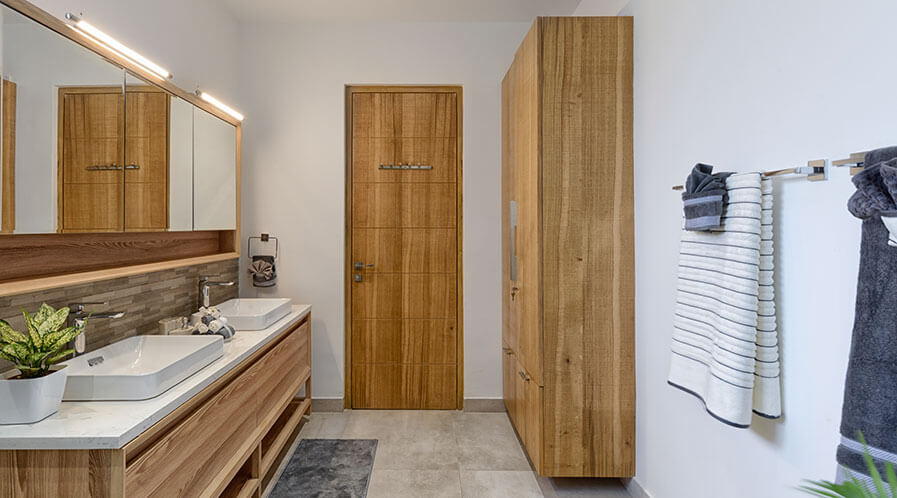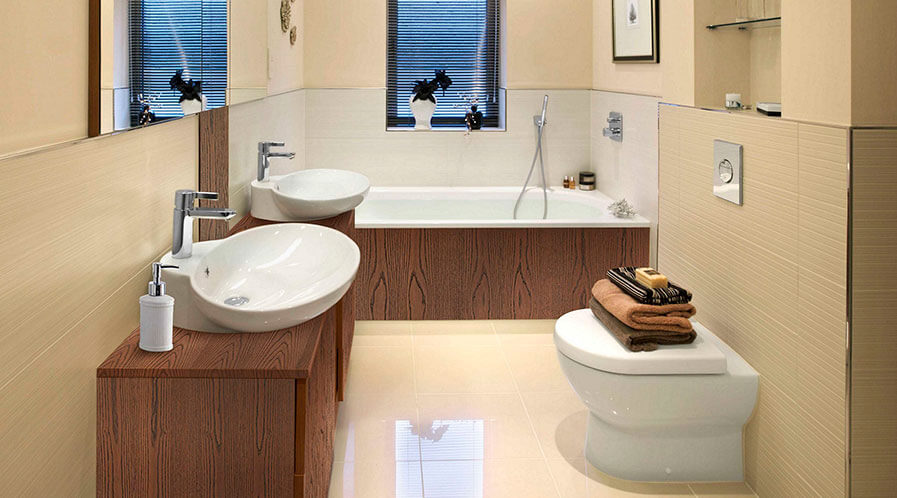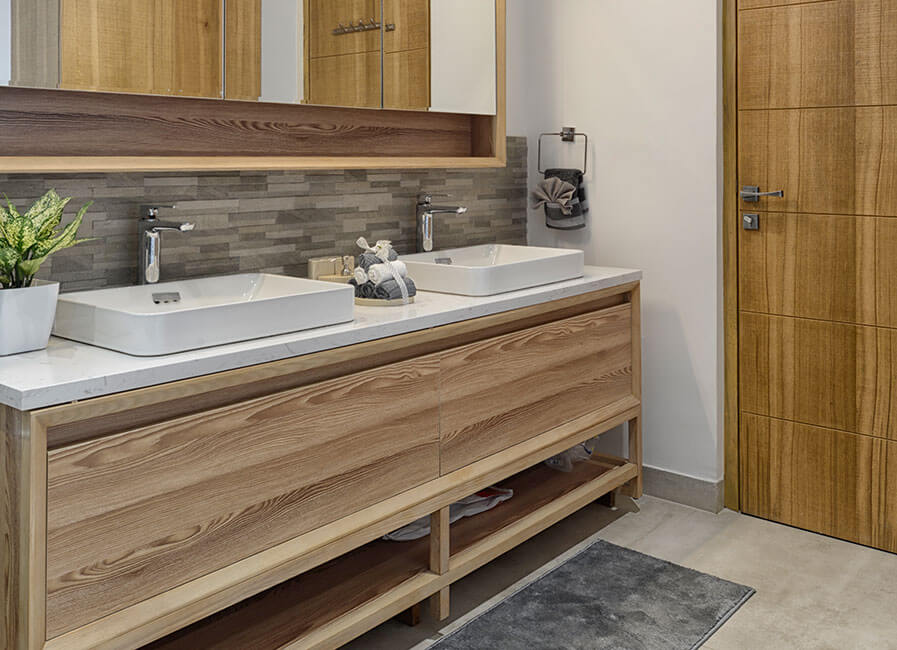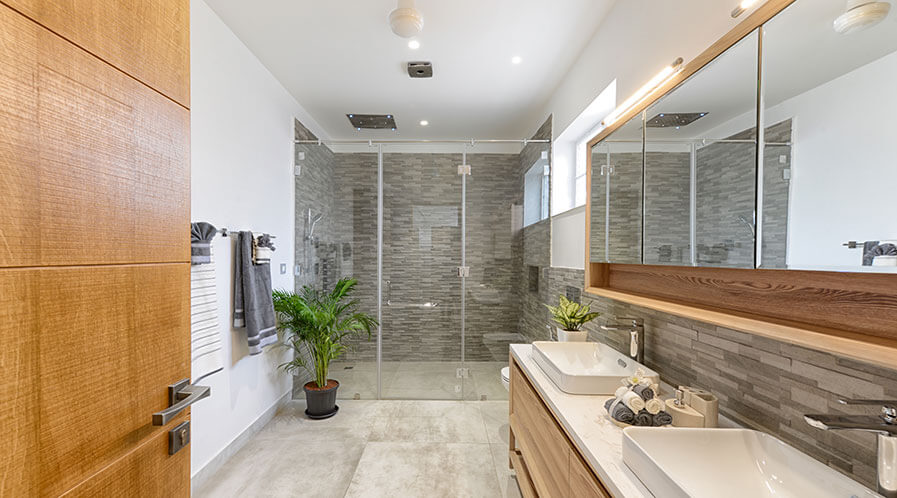Wood as a Material for Washroom
Despite the many challenges associated with using wood in a washroom, the raw and rustic aesthetic lends a lovely vibe to the space and makes the challenges worthwhile, writes Mrinmoy Dey
The evolution of washroom as a personal space for relaxation and rejuvenation has two major takeaways from design perspective. First, improving the functionality and making spa-like facilities available in washroom becomes a priority. User experience is enhanced through technologically advanced showers, WCs and gadgetries. Secondly, in the busy city life washroom space is the one which is supposed to provide the ‘me time’ and thus a feeling of proximity to nature helps in rejuvenating. Additionally, the washroom space becoming an extension of the adjacent space – be it the bedroom or the study room or the common areas, continuity becomes a factor.
Wood helps in bringing out the rustic theme that makes washrooms appear a part of nature. It’s hard to resist the warmth, texture, and authenticity of wood. Next to stone, it’s one of the most used materials when it comes to home décor. And this link to the outside world provides a sense of harmony and well-being. And, this also helps in maintaining continuity as wood as material is widely used in the interiors.
The biggest concern most people have when it comes to use of wood in washroom is with humidity. The popular theory is that having water all around could damage and warp the natural essence of wood in the long run. While mixing wood with moisture sounds like a recipe for disaster, thanks to a host of modern technologies, this idea no longer holds water. Designers are using wood creatively in the washroom to uplift the aesthetics and feel of the washroom while keeping in mind its limitation.

What makes wood so compelling?
One of the main reasons why people want to use wood in the washroom is to maintain design continuity with rest of the house. Whether it’s on the floor, the countertops, or even in the shower, wood provides a seamless transition from the bathroom into other areas of home. And when used responsibly, wood is an eco-friendly option for almost every style—from minimalist to traditional.
Aesthetically, there are few other materials that add the same feeling to a room as one will find with wood. There is something about the texture of wood that, alone or when paired with plants, stone, and cotton, there’s little that beats it aesthetically. It provides with a sense of harmony and wellbeing. Wood is warm in tone which makes a room feel welcoming. It’s also full of natural lines and patterns which are pleasing to the eye and tend to be missing from other flooring or wall covering options.
“One very important and obvious natural element to introduce in washroom design is the materials. Using wood, stone, earth or lime would be one way of bringing nature into washroom. Besides the usual suspects like flooring, wall, ceiling, there are even wooden washbasins and WCs,” opines Ponni Concessao, Principal Architect, Oscar & Ponni Architects.

Ponni Concessao
Principal Architect, Oscar & Ponni Architects
“One very important and obvious natural element to introduce in washroom design is the materials. Using wood, stone, earth or lime would be one way of bringing nature into washroom.”
Explaining the thought process behind using wood as one of the major material in a residential washroom project in Ahmedabad that is given a library-like look, Chirashree Thakkar, Principal Architect, Thakkar Associates adds, “Wood as a material has a character which signifies classiness. The idea was to create an ambience that is of an office or library and the business of washroom just happens. This washroom has been in existence for few years and survived without any problem. The plumbing areas were consciously isolated to one wall which has minimum wood. The large window which was incorporated from the initial design stage helped in keeping the toilet dry.”
Rohit Suraj, Founder & CEO, Urban Zen says, “Wood as a material in a washroom gives the space a very earthy and rustic feel. However, the durability and integrity of the wood remains at risk of being compromised due to the proximity to both water and steam. Hence, if the use of wood is necessary to support the concept and principle of the design and to maintain the aesthetic of the brief, only the use of properly treated wood with water-resistant coating or specially engineered wood is advisable.”

Chirashree Thakkar
Principal Architect, Thakkar Associates
“Wood as a material has a character which signifies classiness. The idea was to create an ambience that is of an office or library and the business of washroom just happens.”
Applications of Wood
Wood can be used in a variety of ways in a washroom due to evolving technology and innovative water resistance treatment techniques. Some of the most generic uses are cupboards & drawers, wall niches, soap stands & slabs, doors, wash basin counters, mirror cabinets, doors and flooring for dry areas, amongst other things.
Flooring:
Installing wood flooring in bathrooms used to be considered a big no-no. Splashing, standing water, and even high humidity would damage and warp the material, making it useless in a very short period of time. While some argue polyurethane coatings and prefinished hardwood flooring is far more resistant to water damage than before, others argue that some hardwood flooring is actually waterproof. “Hardwood floorings need proactive care and protection but give the most authentic look possible. On the other hand, engineered wood or wood mimicking tiles are maintenance-free for the most part but are easily distinguishable to a keen eye,” opines Rohit.
Walls:
A natural element that many designers prefer for the walls is wood – using live edge wood or reclaimed boards which emphasises the material’s natural beauty in a unique way. Installing wood boards on one of the bathroom’s walls helps in creating a rustic backdrop for the vanity and mirrors. But wood usually doesn’t work well in the shower area because of moisture issues. Both stone and wood are great materials to use in rustic bathrooms and make a great pair when it comes to creating amazing washroom design. While stone can be used for the walls, wood makes an excellent choice for the furniture.
Cabinets:
The most efficient, widely used materials for bathroom cabinets are: Solid wood, plywood, and MDF. Solid wood cabinets, such as oak or maple wood hold up nicely in a bathroom climate, particularly when properly sealed and painted. There should be proper ventilation in the bathroom so that the humidity can escape. There are a wide variety of types of solid wood cabinets in many different finishes that will best accompany the user’s style and enhance the space. Decoratively speaking, solid wood is a classic beauty.
Plywood cabinets are also an option. While there is a wide spectrum in quality, size, and density of plywood, it is best to look for the most solid-like option. Unlike natural wood, plywood does not expand as much—therefore, it may be one step up from solid wood when it comes to picking the right material that will stand up to the humidity. Not only is it more stable in terms of warping and potential water damage, but it is a generally cost-effective option that will last for many years.
MDF is made of other types of compressed wood. It can be more resistant to the moisture of the bathroom than many other materials used for bathroom cabinets when treated and installed properly, and has become highly popular in many of today’s low-cost cabinet options.

Other applications:
A wooden washbasin or tub may seem like a dangerous design choice, but it is not that precarious as it sounds. Cedar, hinoki, and other aromatic hardwoods have been used for centuries in Japan to make deep soaking tubs. Also sailors and shipbuilders around the world have long relied on teak for its natural water resistance. A custom designed tub of hardwoods does give a luxurious “wow factor” to the washroom. Keeping a wooden tub in peak condition requires a rubdown of linseed oil every few months and a daily rinse with tap water to remove the soapy residue.
Selecting the right kind of wood
Another important factor that architects and interior designers pay close attention to is the type of wood being used. There are many different types of wood that are available for flooring installations, and some will be better than others at handling bathroom conditions. Generally softwoods such as pine and fir are avoided as they will be less dense and more apt to absorb moisture. Good hardwood choices include teak, oak, cedar, cherry, maple, ash, walnut, and hickory. According to many designers, hardwood may not be the best flooring choice in a heavily used bathroom where children will splash around but can be perfect in a guest bath or powder room that contains only a vanity and there’s little chance of water puddling on the floor.
Talking about the kinds of wood that are suitable for use in washroom, Rohit adds, “Almost all kinds of wood can be used from a washroom perspective and the decision largely depends on the area and utility for which it is used. For example, most cabinets and partition panels are made of softwood like ply and particle wood but some aesthetically designed counter slabs can be made out of properly treated reclaimed wood as well. Hardwood has been found to have application in several vanity design elements too.”

Rohit Suraj
Founder & CEO,
Urban Zen
“Wood as a material in a washroom gives the space a very earthy and rustic feel. However, the durability and integrity of the wood remains at risk of being compromised due to the proximity to both water and steam.”
Reclaimed wood is a popular addition to both home construction and decor. Recycling and re-shaping old wood into new forms for new purposes is a great way to get the look of a salvaged product without having to distress new raw materials. In the bathroom, beautiful vanities can be crafted from old barn wood as well as countertops and storage shelving. These can transform leftover wood into a beautiful rustic focal point for the washroom.
Make it last longer
The tendency of wood to develop cracks due to moisture is at the root of all major challenges faced when using wood in a washroom design. “The next level of difficulty arises when you have to choose the optimum material to showcase your design. However, the raw and rustic aesthetic lends a lovely vibe to the space and makes the challenges worthwhile,” opines Rohit.
Hardwood floors, wooden walls in the bathroom and even vanity pieces will require express maintenance and possibly a yearly application of finish designed for wet environments. Designers advice adding robust exhaust fans that are able to dry a bathroom quick and reliably, removing moisture, one of the toughest concerns when it comes to wood in the bathroom. But it is well worth the effort.

The dynamic interplay of a richly textured, reclaimed wood countertop with smooth ceramic and gleaming metal fixtures makes an amazing centrepiece to any bathroom. And there are several ways to protect the wood from water splashes. Tung oil—a naturally-derived product that is used to waterproof ship hulls—is one such option. Tung oil provides a non-toxic, water-resistant finish to any wooden countertop. A mixture of linseed oil, wax, and a catalytic drier helps prevent stains from seeping into the surface and adds a satin finish with a rich hue. The most durable option for protecting wood countertop is epoxy. It is a plastic-like resin used to coat surfboards. While an epoxy seal is permanent and virtually impossible to penetrate, it also gives the countertop a plastic look, taking away from the natural feel of the wood.
Tags: Cabinet, Connecting with Nature, Luxury Washroom, Rustic Washroom, Wood



